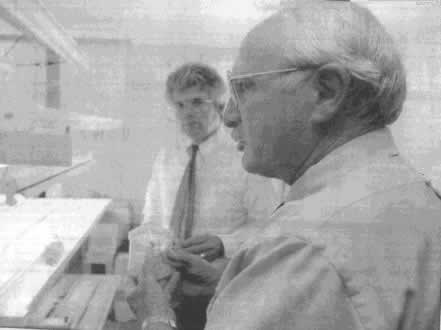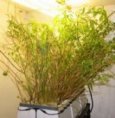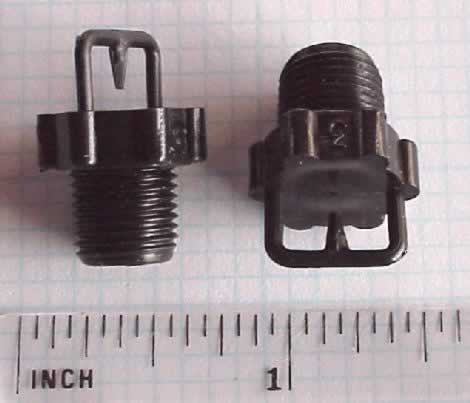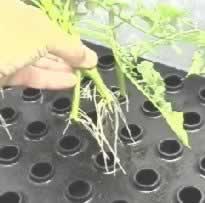

Developing a Sterile Environment for Aeroponic Plant Growth
Author: James Clawson, Sr. Researcher, BioServe Space Technologies
(NASA SPACE COMMERCIALIZATION CENTER)
Background

Richard J. Stoner II is the first person to commercialize aeroponic technology and the process of growing plants in air. In 1983, Stoner filed for a patent on an Aeroponic method and apparatus he developed on his farm in Longmont, Colorado. It was originally known as the Genesis Growing System. Due its advanced oxygenation process the Genesis Aeroponcis was a quantum leap over hydroponics. It offered, for the first time ever, a sterile closed-loop air environment that is applicable to cloning and growing of all plants. The aeroponic patent was granted in 1985 and marketed worldwide by Genisis Technology, Inc. Boulder, Colorado, the company Stoner founded. Today there are thousands of Genesis aeroponic systems operating worldwide. Stoner's efforts launched the aeroponic industry as we know it today. Stoner has been the Principal Investigator and author of several recent NASA aeroponic reseach grants and is an active corporate member of BioServe Space Technology. His research efforts lead to the development of the first biocontrol product to activate a plants immune like systems. His product has been proven effective to replace pesticides aboard the space shuttle and the MIR space station. Stoner's companies continue to market the Genesis Aeroponic which are trademarked as Site Index.

This Aeroponic technology provides the plants with an enclosed sterile polystyrene chamber that retains mist and heat. The nutrient/mist is delivered via a microprocessor Hydrocontrol that pulses a hydro-atomized spray at specific intervals for a specific duration to the plant and/or seeds which are suspended inside the chamber. They are supported in individual plant support structures. An essentially disease free environment is maintained due to the fact that no plant is in contact with another plant and each spray pulse is sterile. This is not the case for soil or aggregate media where disease can spread throughout the media, infecting the plants. For this reason the soil, aggregate or rockwool media is sterilized after propagating each successive crop. In most cases the soil or aggregate media is discarded and replaced with certified sterile media. Another distinct advantage of the Aeroponic technology is that if a particular plant does become infected with a disease it can quickly be removed from the plant support structure without disrupting or infecting the other plants. Additionally, the Aeroponic chamber can easily be cleaned if unsanitary conditions occur by injection of dilute amounts of disinfectants.

As mentioned above, there are thousands of Genesis installations worldwide comprised of commercial greenhouses, nursery growers, university researchers and horticultural schools. This Aeroponic technology is proven to accelerate root development and plant growth. Over the years, the Stoner has been in personal contact with users of the Aeroponic technology. Research carried out by the Aeroponics International and that of the users has enabled the Aeroponics International to compile an extensive list of plants that have been propagated and grown utilizing the Aeroponic technology. Research carried out by others on peach tree cuttings shows a tremendous potential for Aeroponics as a suitable means of growing plants. Aeroponics International's data reveals that Aeroponic propagation is applicable to hundreds of plant species. Aeroponics International has demonstrated its ability to provide Aeroponic conditions that can sustain a variety of crop plant species.

The patent for an Aeroponic method and apparatus developed by the Aeroponics International differs quite extensively from previously defined Aeroponic technology. The Aeroponics International's patent takes into consideration the disease control and plant survival aspects that other researchers either overlooked or failed to resolve. Tibbitts briefly researched Aeroponics and concluded that system failures of his Aeroponic apparatus would result in complete loss of plant life (Tibbitts et al., 1994). Tibbitts used a vaporizer that delivers a continuous mist or fog to the stem and root sections of the plants in their apparatus. This approach's main limitation, one which Tibbitts addressed, is that interruption of the fog to the plants would soon cause loss of plant life due to lack of water. Another limitation of a continuous mist is that it can contribute to fungal and bacterial growth in the vicinity of or on the plants. A third limitation found by researchers is the difficulty in delivering nutrients to all the plants when they had a high density of plants in their Aeroponic chamber (Coston et al., 1983).

The Aeroponics International's Aeroponic system overcomes these limitations. The system uses reverse osmosis (RO) water. The RO equipment removes 99.9% of all minerals and 100% of all bacteria and viruses from the water supply. The RO water is pulsed into the Aeroponic system under high-pressure while injecting a sterilized supply of micro nutrients with each pulse. The spray pulse is of a short duration, lasting between 3 and 6 seconds. The interval between pulses can be anywhere from minutes to weeks, depending upon the species of plants being grown in the system.

The hydro-control unit generating the pulse of water/micro-nutrient solution delivers it to the hydro-jets in the lower portion of chamber. These jets create a hydro-atomized spray that reaches the stem and root sections. The highly pressured water/micro-nutrient molecules are forced into the vicinity of the plant stem and roots. This accomplishes several things: first, each plant receives adequate moisture and nutrient feeding; second, the force of the spray washes the plants of any contaminants or pathogens clinging to the plant stems or root sections. Densities of as many as 12 plants per square inch have been achieved by the Aeroponics International without loss of plant life. The micro nutrient injector can be configured to rinse the plants with pure water as needed to help maintain cleanliness of the system. Growth hormones may also be injected either separately or in conjunction with micro nutrients.

The vapor and humidity created by the high-pressure spray is retained in the Aeroponic chamber by a vapor retention shield or covering. At the end of each spray-pulse the water/micro-nutrient solution is completely drained from the Aeroponic chamber. The effluent can be processed by the RO equipment for re-use as well as for reclaiming the micro nutrients. The following figure (Fig. 1) shows the basic features of the Aeroponics International's Aeroponic system.
Figure 1
 |
|
Environmental Conditions for Aeroponic Growing

Maintaining a pathogen free environment in the Aeroponic system is dependent on several important factors:
1.) The use of pathogen free or pathogen resistant plants or seeds
2.) The highly sanitary conditions of the facility housing the Aeroponic system
3.) The delivery of pure water to the system in each pulsed spray
4.) The injection of sterilized micro nutrients into the pulsed spray

The air/spray ratio is an important factor for the success of plant propagation and seed germination in the Aeroponic systems. Stoner has spent 15 years researching and developing Aeroponic technology to maximize plant growth. This Aeroponic technology does not rely on soil media or aggregates. Other researchers suggest using hydroponic technology that incorporates aggregates to maintain water cohesion on developing root systems (Tibbitts et al., 1994); however, these aggregates may facilitate the spread of pathogens among plants.
Additional environmental requirements for an Aeroponic propagation system:
* Adequate air exchange and venting
* Adequate delivery of fresh clean water free of heavy levels of sulfur and calcium (75 psi min. water pressure)
* Light ( natural sun or sufficient levels of artificial light that approach natural conditions)
* Adequate heating and cooling ( min. room temperature 65 degrees F and max. 90 degrees F)
* Adequate sanitary conditions (free of pathogens and insects)
Aeroponic BenchTop Units for indoor growingGeneral Overview of Aeroponics
Tomato crops produced using Aeroponics
Trees and Shrubs Database Successfully propagated using Aeroponics
See the Component Descriptions of the above systems
Information on Aeroponic Growing
How to maintain a sterile environment for plant growth
Understanding Light Energy for Plant Growth
Biocontrol info:
BEYOND All Natural Plant Amendment™ Brochure
Purchase ODC / Beyond Biocontrols and Aeroponic Units and Systems
Use natural biocontrol products visit www.aeroponics.com